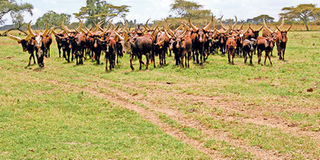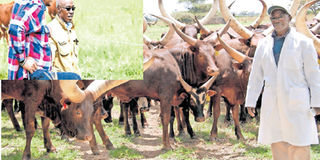Lessons from President’s farm

A herd of Ankole cattle at Gicheha Farm, which belongs to President Uhuru Kenyatta. The farm is a spectacle, hosting a number of imported beef breeds that include the famous Ankole from Uganda and Brangus, Charolais, Hereford and Brahman and also local breeds like the the Borans and Sahiwals. PHOTO | FRANCIS MUREITHI | NMG
What you need to know:
- Gicheha Farm in Nakuru, which the President visits regularly, has top quality animals that include Ankole, Brangus, Charolais, Hereford and Brahman.
- The more than 4,000-acre Gicheha Farm hosts some 1,000 animals, a majority of them imported from South Africa.
- As the animals graze in the paddocks, one can certainly note that this is not your ordinary beef farm, its prominent owner notwithstanding.
- Each animal on the farm has a file that documents their history, breed name, date of birth, parent breed, hardiness, weight at birth, disease history, reason for disposing it and expected maturity date for the market.
If you ask an ordinary Kenyan on the street what President Uhuru Kenyatta’s next love after politics could be, farming may certainly not feature prominently in the response.
Some may guess golf or even listening to music going by his memorable singing of the classical song, Safari ya bamba ni machero, and the support he has offered artists.
But unaware to many, the President’s love for cattle sees him spend a good time on his expansive Gicheha Farm, located a kilometre off Nakuru — Eldoret highway.
A canopy of well-manicured grevillea robusta trees welcome one to the farm, stretching some 500 metres away from the gate, with Boma Rhodes grass sitting in the field on either side of the driveway.
The farm is a spectacle, hosting a number of imported beef breeds that include the famous Ankole from Uganda and Brangus, Charolais, Hereford and Brahman. Local breeds include the Borans and Sahiwals.
“The President loves the beef cattle so much. Whenever he comes, we drive on a pickup truck and visit virtually every corner of the farm inspecting the herd and making inquiries as he seeks to know how every animal is fairing,” David Njoroge, the farm manager and a livestock expert, tells Seeds of Gold.
The more than 4,000-acre Gicheha Farm hosts some 1,000 animals, a majority of them imported from South Africa.
“The Ankoles from Uganda are our latest addition and we have 200 of them. We are also home to 200 Dorper sheep and Galla goats, all which we keep for meat,” says Njoroge.
According to him, the Ankoles are excellent grazers, they grow very fast, can walk for long distances within the farm in search for greener pasture and they have little health issues.
The farm also introduced recently 42 Boer goats from South Africa, but which they are raising for milk.
“In the next two months, we look forward to start milking them. A litre of goat milk goes for between Sh150 and Sh180, the reason why we want to keep them for commercial purposes.”
As the animals graze in the paddocks, one can certainly note that this is not your ordinary beef farm, its prominent owner notwithstanding.
WEIGHT MONITORING
“With such a massive farmland that has more than 1,000 animals, you don’t want to mess up with your management style and daily work plan,” says Njoroge, who has a rich livestock management background, having worked at Agricultural Development Corporation (ADC) and other top beef farms in the country.
All visitors entering the farm, whether on foot or vehicles, must disinfect themselves in several of the footbaths at the entrance.
“Large-scale beef farming is an expensive venture that requires round-the-clock supervision so that diseases do not mess you up. We also have a strict feeding programme that we adhere to and constantly monitor the weight of the cattle, water supply and pasture farming to ensure we have feeds all the time,” he says, adding they take the animals every Tuesday to a dip within the farm.
During the day, the animals graze in the field and in the evening, they retire in the sheds where they are fed minerals, salts and hay, which is mixed in special troughs.

David Njoroge, the farm's manager with the cattle in the farm, and (inset) President Kenyatta with Mr Njoroge inspect the farm. The farm hosts some 1,000 animals, a majority of them imported from South Africa. PHOTO | FRANCIS MUREITHI | NMG
To ensure the animals are in good health, the farm has employed a veterinary officer, who monitors the bulls 24 hours.
A tight vaccination regime has further helped the farm remain disease-free, two years after it was launched.
“Our animals are vaccinated against foot and mouth disease, anthrax, and Rift Valley fever twice a year while lumpy skin disease is done once a year,” explains Njoroge, adding deworming is done every three months.
Bull calves are castrated after seven months to avoid breeding. “Castrating a young bull at the right age is important as you are guaranteed a top quality animal that will fetch you good money in the market,” says Njoroge, 50.
So far, not a single animal has been sold as the management builds up the stock, checking the monthly weight gain keenly.
“Weight monitoring is the hallmark of beef farming because it gives you an indicator whether your animals are heading in the right direction. The ideal weight for sale of a beef animal is between 450kg and 500kg. We will sell in the local market,” says Njoroge.
Each animal on the farm has a file that documents their history, breed name, date of birth, parent breed, hardiness, weight at birth, disease history, reason for disposing it and expected maturity date for the market.
The farm, which employs about 30 workers, has a hay stock that can last for three years if the rains fail. At least 2,000 acres is under Boma Rhodes grass for hay production.
TARGET GROWTH RATE
“We buy the pasture seeds from Kenya Seeds Company and during planting, we apply nitrogen fertiliser and later CAN and this makes the grass to shoot up faster,” offers Njoroge, noting a sister dairy farm is in Ruiru.
Ronald Kimetei, a livestock specialist from Egerton University, says farmers venturing into large-scale beef farming must know the agro-ecological zone where they are rearing the animals.
“With that kind of information, you can determine the right stocking density of the animals per unit area, which is usually five to six animals per acre. For large-scale beef farming, it is advisable to rear them outdoor so that you get maximum returns.”
A farmer must also have a target growth rate by monitoring weight gain per day, post weaning weight gain, and weight at one year.
“You set realistic weight targets, the ideal being half a kilo per month, and design rations to help you achieve that target which must also be supplemented by concentrates such as grains and quality roughages like silage,” says Kimetei.
To monitor the weight, he advises that the animals must be weighed periodically.
“After every two weeks, the animals must be weighed. With large-scale beef farming, one must invest in a weighing bridge.”
For proper disease management, he advises farmers to put stringent bio-security measures.
“Restrict the number of people and vehicles that move into the farm and should you allow movement, then they should pass through footbath and tyre bath for vehicles.”
A farmer must also design a vaccination programme depending on the diseases that are endemic in an area.
****
Get it fast
Beef animals need great care
Beef animals must be handled with utmost care because any slight lapse would result in death and diseases.
The calves feed on their mother’s milk until they are five months when they are weaned. However, they are not taken direct to the feedlot but are put on concentrates that include proteins, cotton seeds, sunflower and grains like oats for 18 months until they attain 250kg.
Then they are transferred to the main feeding lot.

